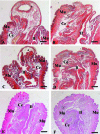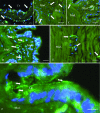The earthworm Dendrobaena veneta (Annelida): A new experimental-organism for photobiomodulation and wound healing
- PMID: 29569873
- PMCID: PMC5820523
- DOI: 10.4081/ejh.2018.2867
The earthworm Dendrobaena veneta (Annelida): A new experimental-organism for photobiomodulation and wound healing
Abstract
Photobiomodulation (PBM) is a manipulation of cellular behavior using non-ablative low intensity light sources. This manipulation triggers a cascade of metabolic effects and physiological changes resulting in improved tissue repair, of benefit in the treatment of tissue injury, degenerative or autoimmune diseases. PBM has witnessed an exponential increase in both clinical instrument technology and applications. It is therefore of benefit to find reliable experimental models to test the burgeoning laser technology for medical applications. In our work, we proposed the earthworm Dendrobaena veneta for the study of non-ablative laser-light effects on wound healing. In our preliminary work, D. veneta has been shown to be positively affected by PBM. New tests using D. veneta were set up to evaluate the effectiveness of a chosen 808 nm-64 J/cm2-1W-CW laser therapy using the AB2799 hand-piece with flat-top bean profile, on the wound healing process of the earthworm. Effective outcome was assimilated through examining the macroscopic, histological, and molecular changes on the irradiated posterior-segment of excised-earthworms with respect to controls. Three successive treatments, one every 24 hours, were concluded as sufficient to promote the wound healing, by effects on muscular and blood vessel contraction, decrement of bacteria load, reduction of inflammatory processes and tissue degeneration. D. veneta was demonstrated to be a reliable experimental organism that meets well the 3Rs principles and the National Science Foundation statement. Through their genetic and evolutionary peculiarity, comparable to those of scientifically accredited models, D. veneta allows the effect of laser therapies by multidisciplinary methods, at various degree of complexity and costs to be investigated.
Keywords: Heat Shock Protein; Low Level Laser Therapy; anti-inflammatory; cell proliferation.; laser irradiation; scarring; tissue repair.
Conflict of interest statement
Conflict of interest: The authors state no conflict of interest and have received no payment in preparation of this manuscript.
Figures










Similar articles
-
Photobiomodulation with 808-nm diode laser light promotes wound healing of human endothelial cells through increased reactive oxygen species production stimulating mitochondrial oxidative phosphorylation.Lasers Med Sci. 2019 Apr;34(3):495-504. doi: 10.1007/s10103-018-2623-5. Epub 2018 Aug 25. Lasers Med Sci. 2019. PMID: 30145725
-
The photobiomodulation effect of higher-fluence 808-nm laser therapy with a flat-top handpiece on the wound healing of the earthworm Dendrobaena veneta: a brief report.Lasers Med Sci. 2018 Jan;33(1):221-225. doi: 10.1007/s10103-016-2132-3. Epub 2017 Jan 6. Lasers Med Sci. 2018. PMID: 28063017 No abstract available.
-
Photobiomodulation therapy on wound treatment subsequent to Q-switched Nd: YAG laser tattoo removal in rat model.J Biophotonics. 2017 Oct;10(10):1287-1291. doi: 10.1002/jbio.201600295. Epub 2017 May 2. J Biophotonics. 2017. PMID: 28464516
-
Laser photobiomodulation of wound healing: a review of experimental studies in mouse and rat animal models.Photomed Laser Surg. 2010 Jun;28(3):291-325. doi: 10.1089/pho.2008.2446. Photomed Laser Surg. 2010. PMID: 19995230 Review.
-
Craniofacial Wound Healing with Photobiomodulation Therapy: New Insights and Current Challenges.J Dent Res. 2016 Aug;95(9):977-84. doi: 10.1177/0022034516648939. Epub 2016 May 9. J Dent Res. 2016. PMID: 27161014 Review.
Cited by
-
A Narrative Review on Oral and Periodontal Bacteria Microbiota Photobiomodulation, through Visible and Near-Infrared Light: From the Origins to Modern Therapies.Int J Mol Sci. 2022 Jan 25;23(3):1372. doi: 10.3390/ijms23031372. Int J Mol Sci. 2022. PMID: 35163296 Free PMC article. Review.
-
Twenty years of histochemistry in the third millennium, browsing the scientific literature.Eur J Histochem. 2020 Dec 29;64(4):3213. doi: 10.4081/ejh.2020.3213. Eur J Histochem. 2020. PMID: 33478199 Free PMC article.
-
Photobiomodulation on isolated mitochondria at 810 nm: first results on the efficiency of the energy conversion process.Sci Rep. 2024 May 14;14(1):11060. doi: 10.1038/s41598-024-61740-w. Sci Rep. 2024. PMID: 38744931 Free PMC article.
-
Non-mammalian Hosts and Photobiomodulation: Do All Life-forms Respond to Light?Photochem Photobiol. 2019 Jan;95(1):126-139. doi: 10.1111/php.12951. Epub 2018 Jul 23. Photochem Photobiol. 2019. PMID: 29882348 Free PMC article. Review.
-
Histochemistry as a versatile research toolkit in biological research, not only an applied discipline in pathology.Eur J Histochem. 2018 Dec 21;62(4):3006. doi: 10.4081/ejh.2018.3006. Eur J Histochem. 2018. PMID: 30572698 Free PMC article.
References
-
- Mester E, Szende B, Tota JG. Effect of laser on hair growth of mice. Kiserl Orvostud 1967;19:628-61.
-
- Parker S. Photobiomodulation: an overview of current concepts and understanding. Benedicenti A, Benedicenti S, editors. Atlas of Laser Therapy, IV edition. Brescia, Italy; Teamwork media srl; 2016. p. 139-155.
-
- Karu T. Primary and secondary mechanisms of action of visible to near-IR radiation on cells. J Photochem Photobiol B 1999;49:1-17. - PubMed
-
- Hamblin MR, Waynant RW, Anders J, editors. Mechanisms of low level light therapy. International Society for Optics and Photonics. Proc. SPIE 6140; 2006. p 12.
-
- Karu TI, Afanas'eva NI. Cytochrome c oxidase as the primary photoacceptor upon laser exposure of cultured cells to visible and near IR-range light. Dokl Akad Nauk 1995;342:693-5. - PubMed
MeSH terms
Substances
LinkOut - more resources
Full Text Sources
Other Literature Sources

